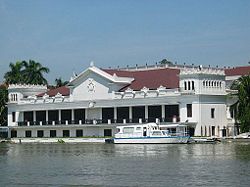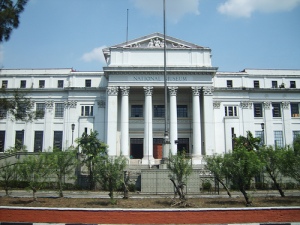With cities around the world building skyscrapers that pierce the sky, making islands out of sand and just building for the sake of building, I wonder what’s the Philippines, as a sovereign nation, doing during this construction boom or virtually “reach-for-the-sky or sky’s-the-limit” quest?
During the Spanish era, the Indios of old built formidable fortresses on behest of the then powers-that-be, the Spaniards. When the Americans defeated Spain 1898, it ruled the Philippines until 1945.

Malacañang Palace
Malacañang Palace, a summer home originally built in 1802 by Spanish aristocrat Don Luis Rocha, then subsequently purchased by the state in 1825. When the 1869 earthquake leveled the Palacio del Gobernador (Governor’s Palace), where then the Governors-General of the Philippines originally resided in Intramuros; Governor General Rafael de Echague y Berminghan, previously governor of Puerto Rico, became the first Spanish governor to occupy Malacañang Palace. After the Spanish-American War, the Palace became the residence of the American Governor-Generals. William Howard Taft was its first American Civil Governor resident in 1900. Upon the establishment of the Commonwealth of the Philippines, on November 15, 1935, President Manuel L. Quezon became the first Filipino resident of Malacañang Palace. It has been the official residence of the President of the Philippines since. (Wikipedia, 2009)

National Museum
The National Museum began as the Insular Museum of Ethnology, National History and Commerce under the Department of Public Instruction in 1901. In 1916, the Philippine Legislature passed Act No. 2572 organizing the Philippine Library and Museum. American Architect, Daniel Burnham designed in 1918 the building which originally housed the Philippine Congress. In 1951, Executive Order No. 392 transferred the National Museum to the Department of Education. In 1988, President Corazon Aquino issued Presidential Proclamation No. 269, declaring 1988 to 1998 as “The Decade of Centennials of the Filipino Nationalism, Nationhood and the Philippine Revolutionary Movement“. President Fidel V. Ramos signed Administrative Order No. 246 on 26 January 1996 creating a Presidential Committee to oversee the rehabilitation of the National Museum complex which included the turnover of various government buildings to The Museum. On February 12, 1998, Ramos signed Republic Act No. 8492, also known as the ‘National Museum Act of 1998’. Four months later, the new National Museum was opened with the formal inauguration of the National Museum of the Filipino People in the former Finance building. (WikiPilipinas, 2008n).
(more…)
Reaching for the Sky?
Tags: American, Bagong Nayong Pilipino, Building, Bunton Bridge, Burj Dubai, Cagayan, CCP, Construction, Corazon Aquino, Cultural Center of the Philippines, Decade of Centennials, Dubai, Efraim C. Genuino, Engineer, Entertainment City, Ferdinand E. Marcos, Fidel V. Ramos, Governor's Palace, Governor-General, Indios, Intramuros, Leyte, Light Rail Transport, Luis Rocha, Maharlika Highway, Malacañang Palace, Malaysia, Manila Bay, Manuel L. Quezon, Marcos Bridge, Metro Rail Transit, NAIA-3, National Museum, Ninoy Aquino International Airport, Observation Tower, Official Residence, PAGCOR, Palacio del Gobernador, Petronas Towers, Philippine Amusement and Gaming Corp., Philippine Convention Center, Philippines, Samar, San Juanico Bridge, San Juanico Strait, Skyscrapers, Spain, Spaniard, Spanish, Spanish-American War, Taipei 101, Taiwan, Terminal 3, William Howard Taft
With cities around the world building skyscrapers that pierce the sky, making islands out of sand and just building for the sake of building, I wonder what’s the Philippines, as a sovereign nation, doing during this construction boom or virtually “reach-for-the-sky or sky’s-the-limit” quest?
During the Spanish era, the Indios of old built formidable fortresses on behest of the then powers-that-be, the Spaniards. When the Americans defeated Spain 1898, it ruled the Philippines until 1945.
Malacañang Palace
Malacañang Palace, a summer home originally built in 1802 by Spanish aristocrat Don Luis Rocha, then subsequently purchased by the state in 1825. When the 1869 earthquake leveled the Palacio del Gobernador (Governor’s Palace), where then the Governors-General of the Philippines originally resided in Intramuros; Governor General Rafael de Echague y Berminghan, previously governor of Puerto Rico, became the first Spanish governor to occupy Malacañang Palace. After the Spanish-American War, the Palace became the residence of the American Governor-Generals. William Howard Taft was its first American Civil Governor resident in 1900. Upon the establishment of the Commonwealth of the Philippines, on November 15, 1935, President Manuel L. Quezon became the first Filipino resident of Malacañang Palace. It has been the official residence of the President of the Philippines since. (Wikipedia, 2009)
National Museum
The National Museum began as the Insular Museum of Ethnology, National History and Commerce under the Department of Public Instruction in 1901. In 1916, the Philippine Legislature passed Act No. 2572 organizing the Philippine Library and Museum. American Architect, Daniel Burnham designed in 1918 the building which originally housed the Philippine Congress. In 1951, Executive Order No. 392 transferred the National Museum to the Department of Education. In 1988, President Corazon Aquino issued Presidential Proclamation No. 269, declaring 1988 to 1998 as “The Decade of Centennials of the Filipino Nationalism, Nationhood and the Philippine Revolutionary Movement“. President Fidel V. Ramos signed Administrative Order No. 246 on 26 January 1996 creating a Presidential Committee to oversee the rehabilitation of the National Museum complex which included the turnover of various government buildings to The Museum. On February 12, 1998, Ramos signed Republic Act No. 8492, also known as the ‘National Museum Act of 1998’. Four months later, the new National Museum was opened with the formal inauguration of the National Museum of the Filipino People in the former Finance building. (WikiPilipinas, 2008n).
(more…)
Share this: